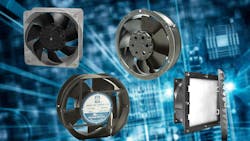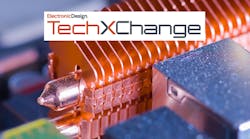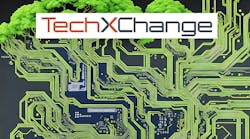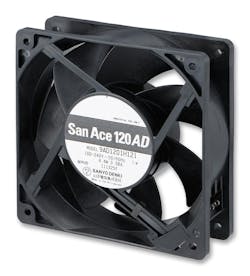EC Fans Make Cooling More Efficient and Sustainable
What you’ll learn:
- Why EC fans are a significant step forward in cooling solutions.
- The sustainable advantage of EC fans.
- Why EC fans are the best of both (AC and DC) worlds.
Cooling electronics in IT and industrial processes causes a significant amount of global electricity consumption. Cryptocurrency mining, for example, generates 25-50 million tons of CO2 emissions in the U.S. each year to meet its power-hungry needs.1
But beyond the climate implications, unwanted heat often degrades the performance and lifespan of electronic devices. Active cooling is a smart way to keep a device's temperature within permissible operating limits, while making it more energy efficient. Active cooling uses system fans to produce airflow around the heat-generating components, removing heat from the equipment.
Conventional AC fans have been the go-to technology for cooling devices. But they are noisy and consume additional power, which puts additional drain on battery-powered devices used in IoT and similar applications.
Electronically commutated (EC) fans are a significant step forward in cooling solutions (see figure). Compared to AC fans, they can enhance a device’s energy efficiency while improving cooling performance. In a nutshell, EC fans outperform legacy technologies using brushless motors that operate on an alternating current, but closely resemble direct-current (DC) motors.
“Electronically commutated” refers to using built-in electronic circuitry to control the speed and direction of the motor’s rotation. This approach not only results in greater energy efficiency, but such fans are quieter than traditional DC fans that rely on mechanical brushes for commutation. EC motors and fans can be connected directly to the AC mains supply, rather than a separate DC power supply. This feature makes them easy to retrofit and provides greater control and higher efficiency.
Why Choose EC Fans for Advanced Cooling
All electric motors transform electrical energy into mechanical energy, but they do this in different ways. How they transform energy is determined by the power supplied to the motor, which, in turn, influences how magnetic fields are formed and regulated.
AC solutions are simple, robust motors that generally run at a constant speed, which changes slightly when mechanical loads are applied to the motor shaft. They’re engineered to run optimally within a specific speed range due to the fixed line frequency they operate on, achieving peak efficiency at a designated point on their performance curve. However, their efficiency noticeably declines when they operate outside this range.
DC motors run on DC power and produce mechanical torque. They have high starting torques and can easily absorb sudden increases in load. DC motors are ideal for applications where wide speed range control is required, as they’re simpler and less expensive than AC motors.
Benefits of Electronically Commutated Motors
EC motors utilize the best aspects of both legacy technologies. They convert AC power to DC, commuting and controlling the speed by regulating the power to the motor. The onboard electronics provide the appropriate amount of current in the correct direction and at the precise time. This action generates magnetic poles within the stator, which interact with the rotor's permanent magnets.
The position of each magnet is determined using Hall-effect sensors. A combination of attraction and repulsion forces is achieved by attracting the appropriate magnets in sequence to the magnetic poles in the stator while simultaneously charging the remaining stator windings with reverse polarity. These attraction and repulsion forces combine to achieve rotation and produce optimal torque.
Maximize Efficiency and Reduce Noise with EC Fans
EC fans offer the same air volume output as AC fans but use far less electrical power, consuming 70% less energy than standard AC technology. Because AC fans operate at a predetermined peak efficiency point on their performance curve, efficiency can drop off considerably on either side of this operating point.
EC fans, on the other hand, have an almost flat efficiency curve, which varies relatively little across the speed range. Such efficiency enables the EC fan to adjust to the level of cooling needed, cutting energy waste from fans running faster than necessary.
While AC fans operate at a fixed speed, EC fans automatically adjust the rotational speed based on the cooling demand. When cooling demand is low, EC fans can run at lower speeds, reducing energy consumption.
As mentioned, EC fans are quieter as well. This makes them ideal for applications where noise must be minimized, such as in residential or in-door commercial spaces.
They can also reduce maintenance costs. The brushes used by AC fans are prone to wear and tear. EC fans, in contrast, have longer operational life spans thanks to their brushless design. These reduced maintenance requirements result in higher cost savings and overall efficiency.
In some EC fans, energy efficiency can be increased further if the pulse-width-modulation (PWM) control input is used to reduce fan speed. The power consumption drops to 48% at 60 Hz and 58% at 50 Hz, respectively, when the speeds are reduced with PWM control.
EC Fans: Helping Create a More Sustainable Future
As we strive to make electronics more sustainable in terms of their energy consumption, EC fans offer a dramatically better way to decarbonize the future. They also offer a sustainable advantage thanks to their longer lifespans and reduced maintenance requirements.
EC fans do a better job of protecting electrical devices from exposure to temperatures beyond their acceptable operating limits. EC fans attain an efficiency level of up to 90%, which translates to better primary energy utilization, reduced heat loss, and longer service life.
Read more articles in the TechXchanges: Cool Designs and Sustainable Electronics.
Reference
1. FACT SHEET: Climate and Energy Implications of Crypto-Assets in the United States, The White House, Sept. 2022.
About the Author

Randall Scasny
Senior Community Content Specialist, Newark
Randall Scasny is a senior community content specialist for Avnet's element14 Community, an electronics industry community of thousands of engineers, industry experts, independent sources, makers, and STEM advocates from all over the world. For more information about the element14 community, visit https://community.element14.com.



